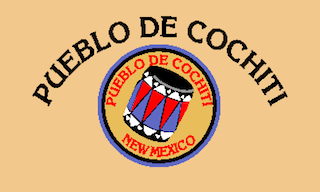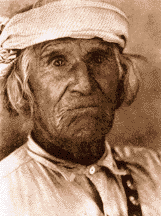
The people of Cochiti
continue to retain their native language of Keres. They
maintain their cultural practices and have instituted programs
dedicated to teaching and educating the younger generation
Pueblo traditions and cultural practices emphasizing the
native language.
Cochiti
is well known for their craftsmanship in making jewelry,
pottery, (storyteller), and drums.
Cochiti (Ko-chi-ti'). A Keresan tribe and its pueblo on the west bank of the Rio Grande, 27 miles south west of Santa Fe, New Mexico. Before moving to their present location the inhabitants occupied the Tyuonyi, or Rito de los Frijoles, the Potrero de las Vacas, the pueblo of Haatze on Potrero San Miguel or Potrero del Capulin, and the pueblo of Kuapa in the Cañada de Cochiti. Up to this time, which was still before the earliest Spanish explorations, the ancestors of the present San Felipe inhabitants and those of Cochiti formed one tribe speaking a single dialect, but on account of the persistent hostility of their north neighbors, the Tewa (to whom is attributed this gradual southerly movement and through whore they were compelled to abandon Kuapa), the tribe was divided, one branch going southward, where they built the pueblo of Katishtya (later called San Felipe), while the other took refuge on the Potrero Viejo, where they established at least a temporary pueblo known as Hanut Cochiti. On the abandonment of this village they retired 6 or 7 miles south east to the site of the present Cochiti, on the Rio Grande, where they were found by Oñate in 1598.
The Cochiti took an active part in the Pueblo revolt of 1680, but remained in their pueblo for 15 months after the outbreak, when, learning of the return of Gov. Otertnin to reconquer New Mexico, they retreated with the Keresan tribes of San Felipe and Santo Domingo, re-enforced by some Tewa from San Marcos and by Tigua from Taos and Picuris, to the Potrero Viejo, where they remained until about 1683, when it was reported that all the villages from San Felipe northward were inhabited. Between 1683 and 1692 the Cochiti, with their San Felipe and San Marcos allies, again took refuge on the Potrero Viejo. In the fall of the latter year they were visited in their fortified abode (known to the Spaniards as Cieneguilla) by Vargas, the reconqueror of New Mexico, who induced them to promise to return to their permanent villages on the Rio Grande. But only San Felipe proved sincere, for in 1692 the Cochiti returned to the Potrero, where they remained until early in the following year, when Vargas, with 70 soldiers, 20 colonists, and 100 warriors from the friendly villagers of San Felipe, Santa Ana, and Sia, assaulted the pueblo at midnight and forced the Cochiti to flee, the Indian allies leaving for the protection of their own homes.
The force of Vargas being thus weakened, the Cochiti returned, surprised the Spaniard, and succeeded in liberating most of the Indian captives. Vargas remained a short time, then burned the pueblo and evacuated the Potrero, taking with him to Santa Fe a large quantity of corn and other booty and nearly 200 captive women. Cochiti was the seat of the Spanish mission of San Buenaventura, with 300 inhabitants in 1680, but it was reduced to a visita of Santo Domingo after 1782. These villagers recognize the following clans, those marked with an asterisk being extinct: Oshach (Sun), Tsits (Water), Itra (Cottonwood), Shuwhami (Turquoise), Mohkach (Mountain Lion), Kuhaia (Bear), Tanyi (Calabash), Shrutsuna (Coyote), Hapanyi (Oak), Yaka (Corn, Hakanyi (Fire), *Dyami (Eagle) *Tsin (Turkey), *Kuts (Antelope), *Shruhwi (Rattlesnake), *Washpa (Dance-kilt), *Kishqra (Reindeer?). In addition, Bandelier notes an Ivy and a Mexican Sage clan.
The Cochiti people are noted for their
hospitality and friendship towards visitors who are welcomed
to many of the annual ceremonies for which Cochiti is
famous.
Many members of the Pueblo live outside the reservation and
have been acculturated into the anglo-Hispanic community,
but most of them continue their association with the Pueblo,
especially during the major feast day. San
Buenaventura’s Day in July. This is marked by dancing
and ceremonies of traditional pattern and authentic
costumes.
Present population 300. The Cochiti people occupy a grant of
24,256 acres, allotted to them by the Spanish government and
confirmed by United States patent in 1864.
English Pronunciation:
"Coh-chee-tee"
Traditional Name: KO-TYIT
I-25, 33 miles north of Albuquerque, exit 259,
north 14 miles on NM 22.
505-465-2244 | www.Pueblodecochiti.org

Antelope
Hunting
Arrow
Boy
Recovers His Wife
Arrow
Boy
Triumphs Over His Mockers
Arrow
Boy's
Son
Arrow
Boy,
Child Of The Witch Man
Arrow
Youth
Arrow
Youth
2
Bat
Boy
Betting
Eyes
Bird
And
Toad Play Hide And Seek
Bloody
Hand-Print
Katcina
Boy Of White House Marries A Girl
of The Village Of The Stone Lions
Buffalo
Hunting
Of The Plains
Bungling
Host
Burro
and the Coyote
Butterfly
Pursuit
Cactus
Lover
Cochiti
Tribe
Contest
for
Wives
Corncob
Boy
Corncob
Boy
Intercedes For His People
Corncob
Boy
Marries Deer Planter's Daughters
Corncob
Boy
Triumphs Over His Mockers
Coyote
And
Beaver Exchange Wives
Coyote
Brings
Her Children
To Play With The Quails
Coyote
Fails
As Initiate
Coyote
Has
A Ball On Her Toe
Coyote
Imitates
Crow
Coyote
Interrupts
The Corn Dance
Coyote
Sings
For The Prairie Dogs
Coyote
Spills
the Stars
Crane
And
Geese
Crow and Hawk
Crow's
Song
Cuisi'nyinawa
Deer
and
Coyote
Duck
Sings
For Her Children
Fox
And
Coyote
Ganadyani
Geese
Go
Shell Gathering
Geese
Talk
The Santa Ana Language
Ginini
(Halfwit)
Half
Rooster
Heluta
and
Nyenyega Contest for a Wife
Heluta
Plants
the Deer
Horned
Toad
Sings In Black Boy's Stomach
How
The
People Came Up From Frijoles
How
They
Came Down From The Mesa
Hummingbird
Has
Food
Industrious
Daughter
Who Would Not Marry
Kotcimanyako
Scatters
The Stars
Lion
And
Grizzly Bear
Locust
Boy
Montezuma
Neglectful Mother
Origin
of the Cat
Scaring
Contest
Tales
of the Cochiti Indians
Woodrat
and Mouse
Challenge Each Other
Woodrats

Artists of
Cochiti
Cochiti's
Best Storytellers
Pueblo
Tribes:
Cochiti
Cochiti
Pueblo
"Katyete or Ko-Chits"
Cochiti's
Best Storytellers
(Pottery - Storytellers)
“Feast Days” at each of the Pueblos are named after the Pueblos’ patron saint. The Pueblos open up their respective Feast Days to the public (see calendar and etiquette pages) where visitors can view the reverant dances and songs offered on those days. Feast Days bring tribal members together to renew their culture, language and native religion. On those days, families prepare food for the many invited visitors coming through their homes, and participate in the activities taking place on their Feast Day. Pueblo Feast Day Dates do not change and are held on the same date each year.
![]() Return to Indigenous Peoples'
Literature
Return to Indigenous Peoples'
Literature
Compiled by: Glenn
Welker
ghwelker@gmx.com
This page last updated 05/25/2019 20:25:26
This site has been accessed 10,000,000 times since February 8, 1996.